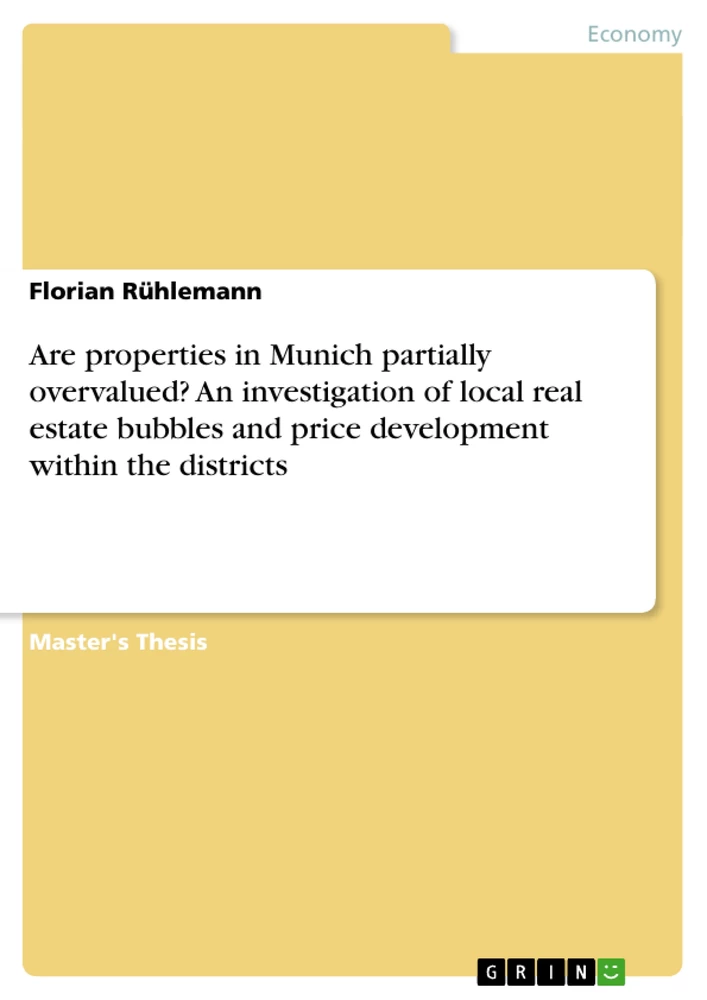
Are properties in Munich partially overvalued? An investigation of local real estate bubbles and price development within the districts
Masterarbeit, 2014
99 Seiten, Note: 1,3
Leseprobe
Table of Contents
- 1 Introduction
- 2 Scope and limitations of research
- 2.1 Data collection techniques
- 2.2 Definition of a real estate bubble
- 2.3 Fundamental value - The stock-flow model
- 3 Literature Review
- 4 City based perspective from 1975 to 2013
- 4.1 Historical development
- 4.1.1 Population and labour market
- 4.1.2 Building and housing
- 4.1.3 Housing and renting prices
- 4.1.4 Interest rate and mortgages
- 4.2 Characteristic ratios
- 4.2.1 Price-to-rent ratio
- 4.2.2 Price-to-income ratio
- 4.2.3 Housing affordability index
- 4.3 Empirical time series analysis
- 4.3.1 The time series model
- 4.3.2 Statistical analysis
- 4.1 Historical development
- 5 District based investigation
- 5.1 District based perspective from 2000 to 2012
- 5.1.1 Development of population in the districts
- 5.1.2 Development of building and housing in the districts
- 5.1.3 Development of housing prices in the districts
- 5.2 Empirical panel data analysis
- 5.2.1 The panel model
- 5.2.2 Cross section versus time series dimension
- 5.2.3 Statistical Analysis
- 5.3 Forecast
- 5.1 District based perspective from 2000 to 2012
Objectives and Key Themes
This master's thesis investigates whether real estate prices in Munich are overvalued, focusing on the existence of local real estate bubbles. The study employs time series and panel data analysis to examine the relationship between housing prices and macroeconomic variables. The goal is to determine the extent of overvaluation, if any, in both a city-wide and district-specific context.
- Identification of potential real estate bubbles in Munich.
- Analysis of the relationship between housing prices and macroeconomic factors.
- Comparison of city-wide and district-level price developments.
- Application of time series and panel data regression models.
- Assessment of housing price overvaluation using stock-flow modeling.
Chapter Summaries
1 Introduction: This chapter introduces the topic of real estate bubbles, referencing the 2008 US housing crisis and its global impact. It then focuses on the situation in Munich, Germany, where high and continuously rising prices raise concerns about potential overvaluation. The chapter establishes the thesis's objective: to investigate the presence of a local real estate bubble in Munich using econometric methods.
2 Scope and limitations of research: This chapter details the methodology used in the study, outlining the data collection techniques employed and providing a clear definition of a real estate bubble within the context of the research. It also introduces the fundamental value concept and its role in assessing potential overvaluation using a stock-flow model. The limitations of the data and the scope of the analysis are clearly defined, providing a crucial framework for interpreting the results.
3 Literature Review: This chapter summarizes existing research on real estate bubbles and price dynamics, laying the groundwork for the empirical analysis. It sets the current study within the context of previous research and highlights any gaps or controversies in the literature. This review serves to contextualize the thesis's findings within the existing body of academic knowledge.
4 City based perspective from 1975 to 2013: This chapter undertakes a city-wide analysis of Munich's real estate market from 1975 to 2013. It examines historical trends in population, labor market dynamics, building and housing activity, and housing and rental prices, alongside interest rates and mortgage conditions. The chapter uses these factors to analyze price-to-rent, price-to-income ratios, and the housing affordability index. These ratios are crucial for understanding market conditions and identifying potential imbalances that could lead to a bubble.
5 District based investigation: This chapter focuses on a district-level analysis of Munich's real estate market from 2000 to 2012. It examines the development of population, building and housing activity, and housing prices in each district. This granular approach allows for the identification of district-specific variations in price dynamics, which might not be apparent in a city-wide overview. The chapter uses panel data analysis to account for temporal and spatial effects, offering a deeper understanding of price patterns.
Keywords
Real estate bubble, housing bubble, fundamental value, Munich, Germany, housing prices, macroeconomic variables, time series analysis, panel data analysis, stock-flow model, price-to-rent ratio, price-to-income ratio, housing affordability index, overvaluation.
Frequently Asked Questions: Munich Real Estate Market Analysis
What is the main topic of this document?
This document provides a comprehensive preview of a master's thesis investigating the potential existence of real estate bubbles in Munich, Germany. It analyzes housing price dynamics using time series and panel data analysis, comparing city-wide and district-level trends.
What are the key themes explored in the thesis?
The key themes include identifying potential real estate bubbles in Munich, analyzing the relationship between housing prices and macroeconomic factors, comparing city-wide and district-level price developments, applying time series and panel data regression models, and assessing housing price overvaluation using a stock-flow model.
What data and methods are used in the analysis?
The analysis uses both time series data (city-wide, 1975-2013) and panel data (district-level, 2000-2012). Data includes population, labor market dynamics, building and housing activity, housing and rental prices, interest rates, and mortgage conditions. Econometric methods employed include time series and panel data regression analysis, along with the use of key ratios such as the price-to-rent ratio, price-to-income ratio, and housing affordability index.
What is the scope and limitations of the research?
The research focuses specifically on the Munich real estate market. Limitations are explicitly defined, acknowledging constraints in data availability and the scope of the analysis. The definition of a real estate bubble is clearly articulated within the context of the study’s methodology.
What are the key findings (as previewed)?
The preview does not reveal specific findings but outlines the methodology used to assess the extent of any potential overvaluation in the Munich real estate market, both at a city-wide and district-specific level. The results of the time series and panel data analyses are presented in later chapters, not included in this preview.
What is the structure of the thesis?
The thesis is structured into five chapters: an introduction, a chapter outlining the scope and limitations, a literature review, a chapter analyzing city-wide data (1975-2013), and a final chapter focusing on a district-level investigation (2000-2012). Each chapter has specific sub-sections detailing the methodology and analysis.
What are the key variables analyzed?
Key variables include housing prices, rental prices, population, labor market indicators, interest rates, mortgage conditions, and various macroeconomic factors. The analysis uses these variables to calculate ratios such as price-to-rent, price-to-income, and housing affordability indices.
What is the definition of a real estate bubble used in this study?
The specific definition of a real estate bubble used in this study is detailed within the scope and limitations chapter. It’s contextually defined within the framework of the stock-flow model used for assessing fundamental value.
What is the purpose of the stock-flow model?
The stock-flow model is used to assess the fundamental value of real estate in Munich, providing a benchmark against which to compare observed prices and identify potential overvaluation indicating a possible real estate bubble.
What are the keywords associated with this thesis?
Keywords include: Real estate bubble, housing bubble, fundamental value, Munich, Germany, housing prices, macroeconomic variables, time series analysis, panel data analysis, stock-flow model, price-to-rent ratio, price-to-income ratio, housing affordability index, overvaluation.
Details
- Titel
- Are properties in Munich partially overvalued? An investigation of local real estate bubbles and price development within the districts
- Hochschule
- Universität Regensburg (Lehrstuhl für Immobilienfinanzierung (International Real Estate Business School, University Ratisborn))
- Note
- 1,3
- Autor
- Florian Rühlemann (Autor:in)
- Erscheinungsjahr
- 2014
- Seiten
- 99
- Katalognummer
- V277647
- ISBN (eBook)
- 9783656702818
- ISBN (Buch)
- 9783656703945
- Dateigröße
- 3487 KB
- Sprache
- Englisch
- Schlagworte
- munich
- Produktsicherheit
- GRIN Publishing GmbH
- Preis (Ebook)
- US$ 40,99
- Preis (Book)
- US$ 52,99
- Arbeit zitieren
- Florian Rühlemann (Autor:in), 2014, Are properties in Munich partially overvalued? An investigation of local real estate bubbles and price development within the districts, München, Page::Imprint:: GRINVerlagOHG, https://www.diplomarbeiten24.de/document/277647
- Autor werden
- Ihre Optionen
- Vertriebskanäle
- Premium Services
- Autorenprofil
- Textarten und Formate
- Services für Verlage, Hochschulen, Unternehmen

- © GRIN Publishing GmbH.
- Alle Inhalte urheberrechtlich geschützt. Kopieren und verbreiten untersagt.
- info@grin.com
- AGB
- Open Publishing
Der GRIN Verlag hat sich seit 1998 auf die Veröffentlichung akademischer eBooks und Bücher spezialisiert. Der GRIN Verlag steht damit als erstes Unternehmen für User Generated Quality Content. Die Verlagsseiten GRIN.com, Hausarbeiten.de und Diplomarbeiten24 bieten für Hochschullehrer, Absolventen und Studenten die ideale Plattform, wissenschaftliche Texte wie Hausarbeiten, Referate, Bachelorarbeiten, Masterarbeiten, Diplomarbeiten, Dissertationen und wissenschaftliche Aufsätze einem breiten Publikum zu präsentieren.
Kostenfreie Veröffentlichung: Hausarbeit, Bachelorarbeit, Diplomarbeit, Dissertation, Masterarbeit, Interpretation oder Referat jetzt veröffentlichen!
- GRIN Verlag GmbH
-
- Nymphenburger Str. 86
- 80636
- Munich, Deutschland
- +49 89-550559-0
- +49 89-550559-10
- info@grin.com
-









